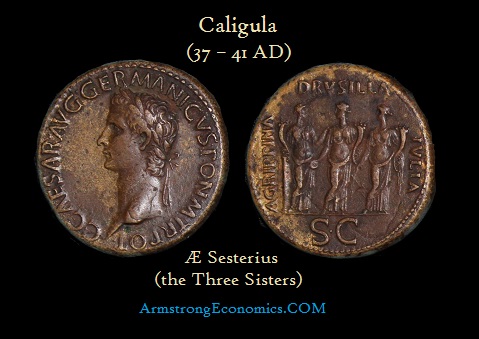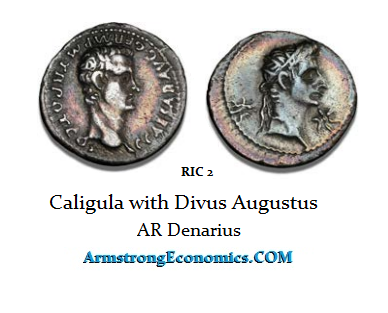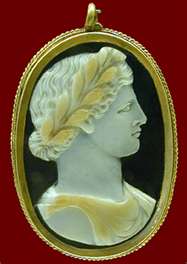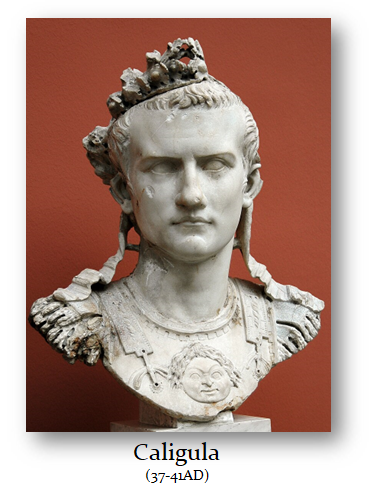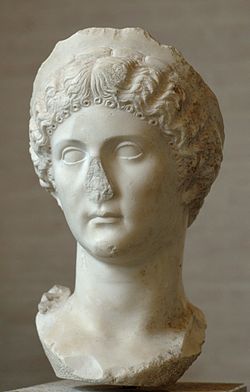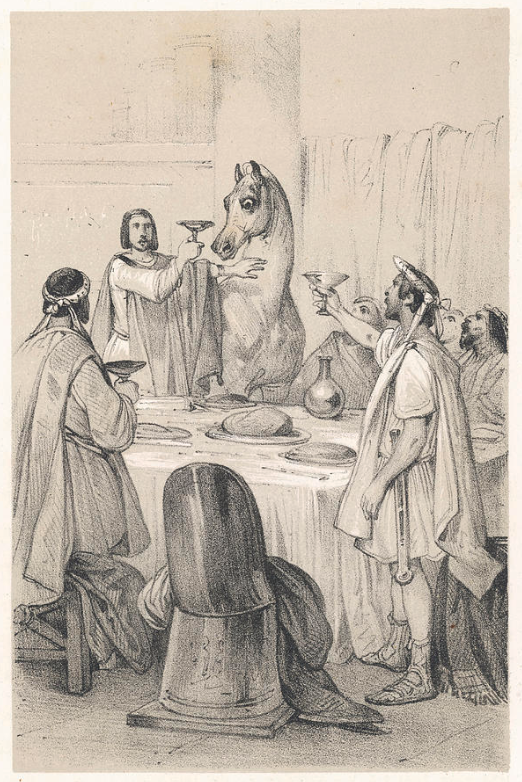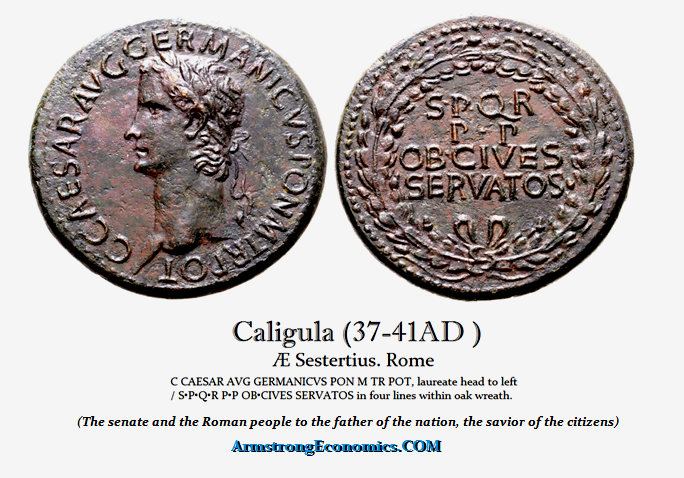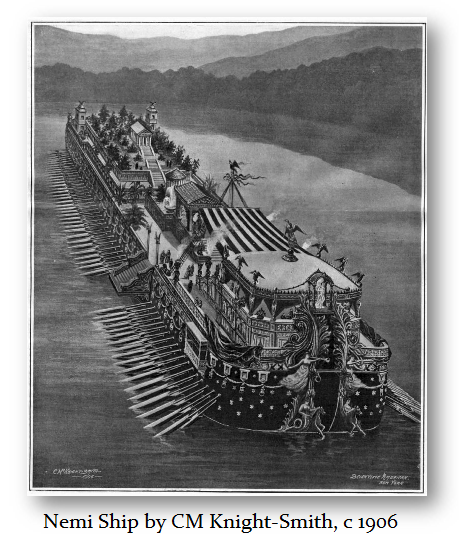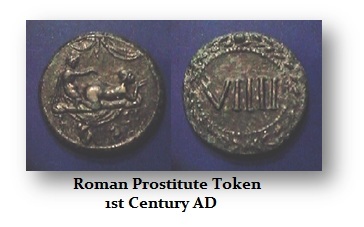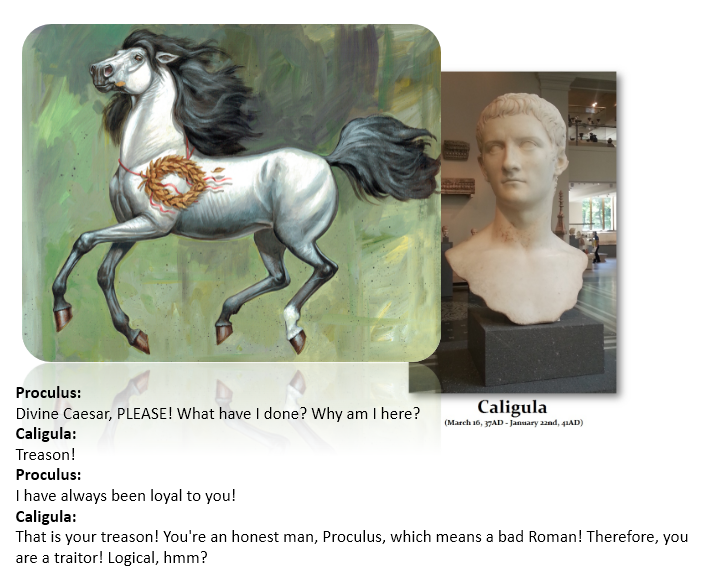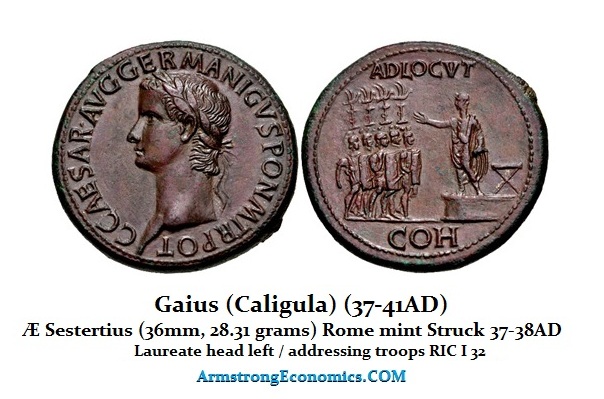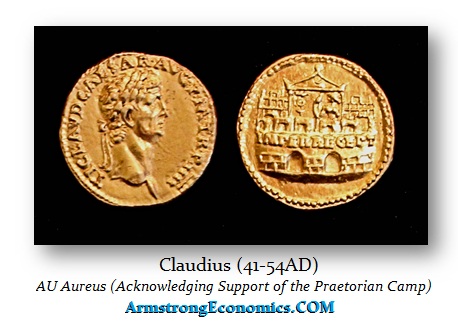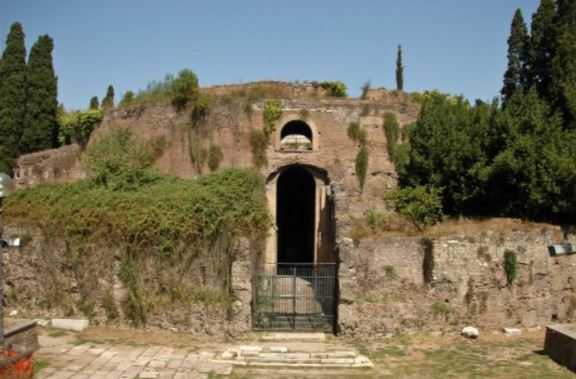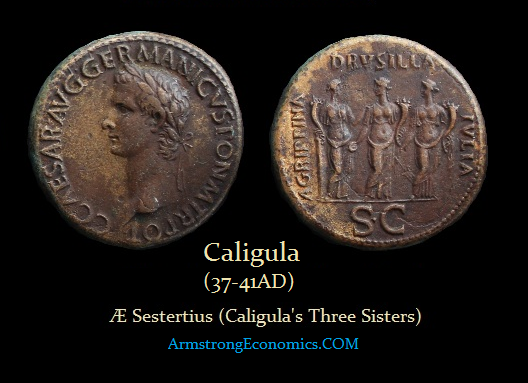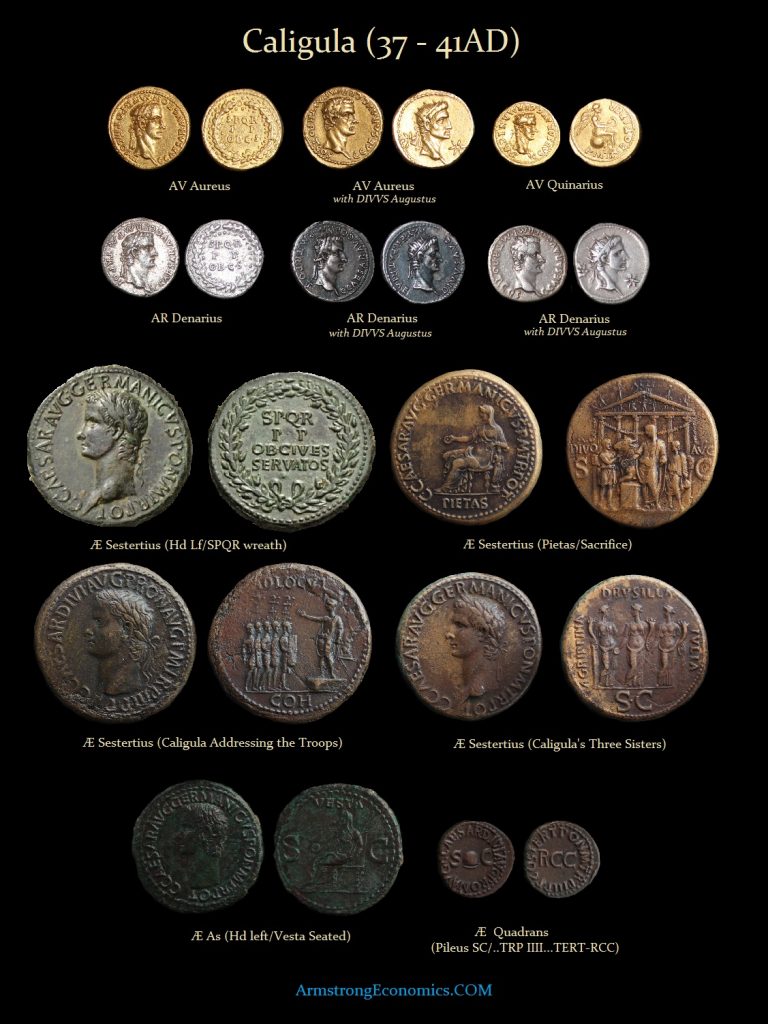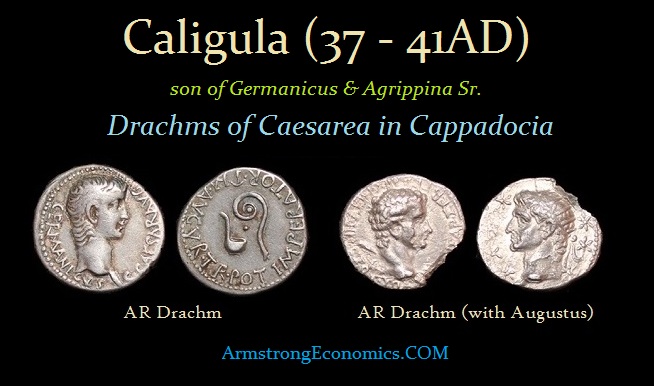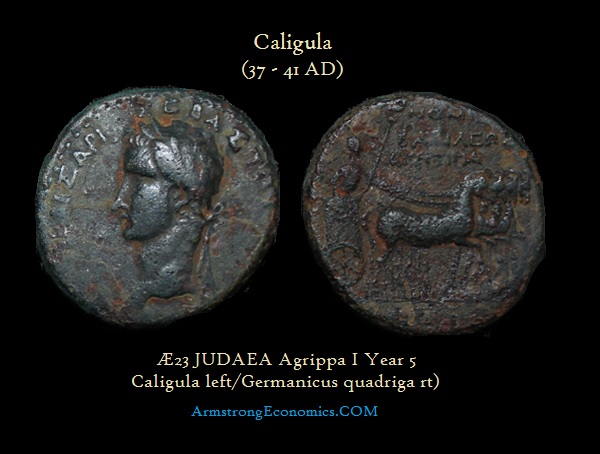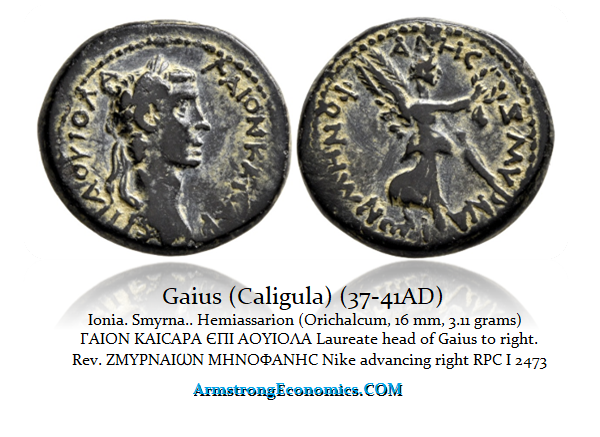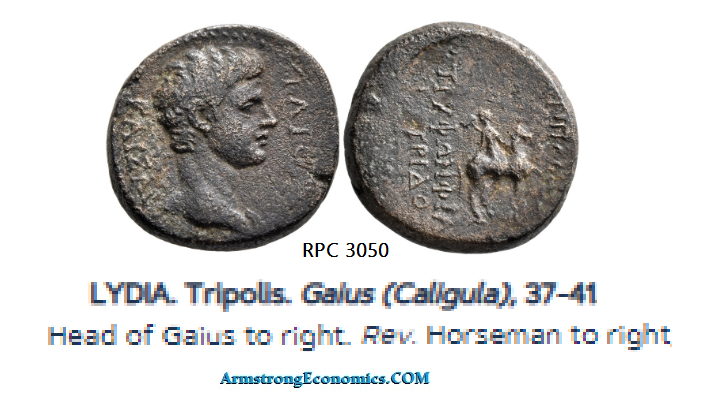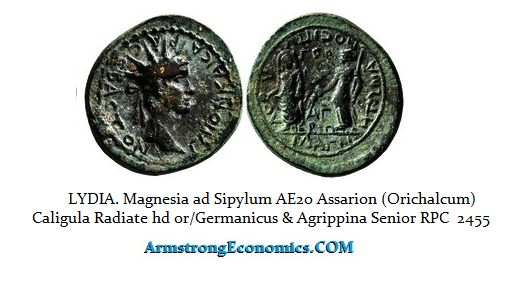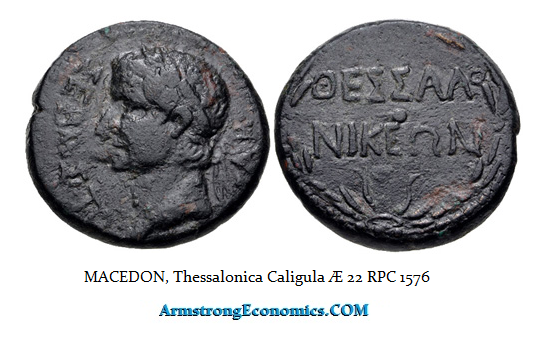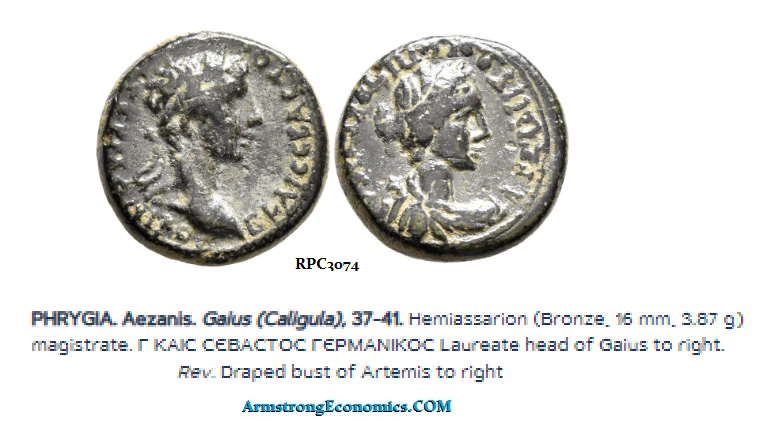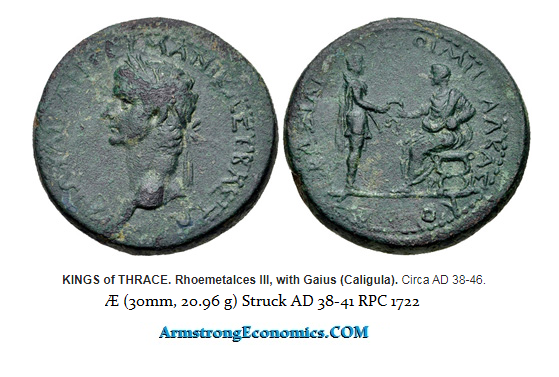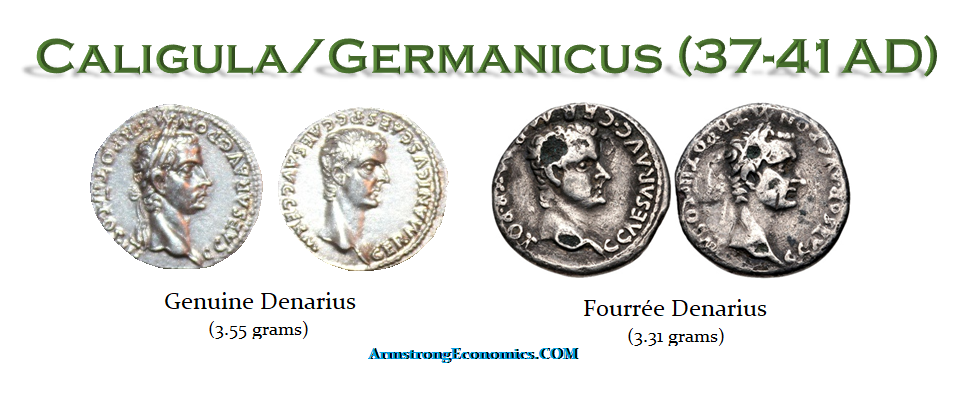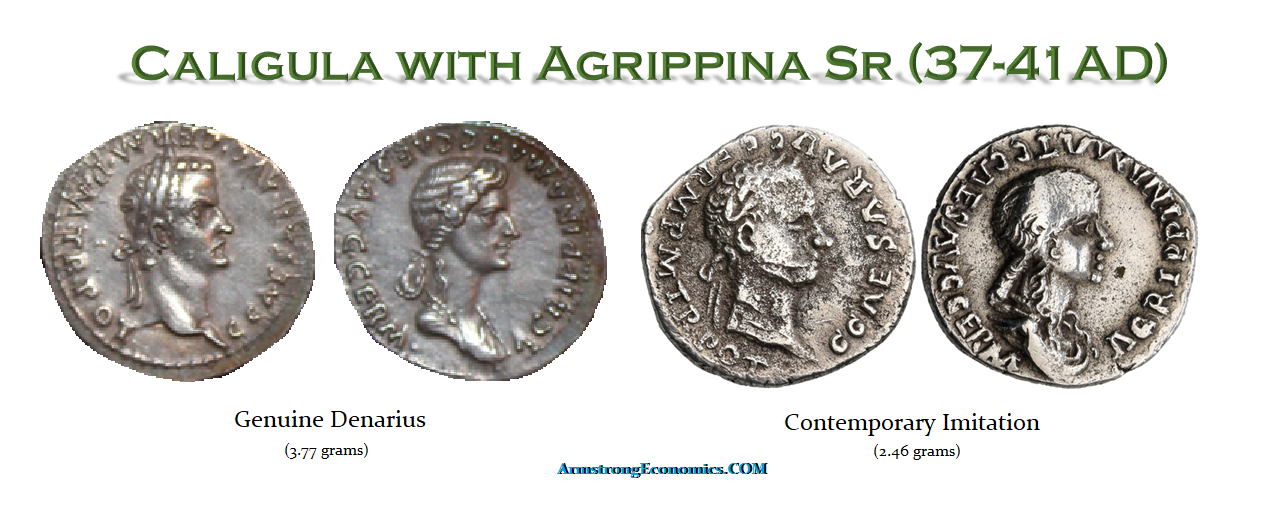Gaius (Caligula)
Emperor 37 – 41 AD
Born 12 AD – Died 41 AD, age 29
Gaius Caesar Germanicus (Caligula) was the youngest son of Germanicus and Agrippina Senior and was born at Antium in 12 AD (modern Anzio), some 25 miles south of Rome. the historian Suetonius tells us that he was a tall, thin man who lost most of his hair on the top of his head and was very pale in color. His nickname, Caligula, was given to him by his father’s troops in Germany. He liked to wear a soldier’s uniform, including a half-boot or Caligula, and the troops affectionately called him “Little Boots.”
Caligula’s father, Germanicus, was the nephew of Tiberius. Before his suspicious death in Antioch in 19AD, Germanicus had won a reputation as a man of distinguished character, rising to the level of a popular hero. This great love that the people of Rome held for his father would serve him well following Tiberius’s death.
Caligula’s 3 Sisters
As a youth, Caligula developed an improper affection for his sisters Agrippina Jr, Drusilla, and Julia Livilla. Caligula somehow managed to escape the fate of his mother and two brothers, Nero and Drusus, who were accused of plotting against Tiberius by the ambitious Sejanus. By keeping their fate to himself, he won the affections of Tiberius and thus entered the line of succession. At the age of 18, Caligula moved to Capri to live with Tiberius in the royal retreat first constructed by Augustus. It is said that both became quite perverted, and Tiberius reportedly boasted that “he was rearing a viper for the Roman people.”
Upon the death of Tiberius on the 16th of March, 37 AD, the commander of the praetorian guard, a man named Macro, ensured the smooth succession of Caligula to the imperial throne. The loving memory of his father, Germanicus, among the people and the Senate ensured that Caligula would become the new emperor. However, Tiberius’ Will had named Caligula as co-heir along with much younger Tiberius Gemellus. However, the Senate bestowed the imperial power on Caligula alone, rejecting the provisions of the former Emperor Tiberius. Gemellus thus became the heir to Caligula.
Caligula & Divus Augustus Silver Denarius
At first, Caligula’s coinage usually portrayed his own portrait with that of either Augustus, his father, Germanicus, or his mother, Agrippina. This was a political ploy to show his legal right to the throne. This political propaganda would eventually give way during the later part of his reign.

One of the new Emperor’s first acts was to travel to the Pontian islands just off the coast of Italy to bring back the ashes of his mother, Agrippina, for proper burial in the tomb of Augustus. He made his uncle Claudius (brother of Germanicus) consul, and his grandmother Antonia was afforded all the privileges Livia once enjoyed. With the family restored, all seemed to be going well.
Antonia
During the first few months of his reign, Caligula ruled with wisdom and clemency, possibly under the tutelage of his grandmother, Antonia. Caligula abolished the treason trials that began under Tiberius and gave generous donatives to the people and a handsome bonus to the praetorian guard. But within two months, it is said that Caligula did not get along with Antonia and that she may have been forced to commit suicide on the 1st of May, 37AD.
Six months after becoming ruler of the Roman Empire, Caligula fell seriously ill. Exactly what the illness was is not certain. As a youth, he had a “falling sickness” known today as epilepsy—an illness shared by Alexander the Great and Julius Caesar. Suetonius tells us that Caligula suffered from insomnia, scarcely sleeping three hours at night while being plagued by horrible nightmares. Whatever the illness was, Caligula was afflicted during September and did not recover until late October or perhaps early November.
After recovering from his illness, Caligula may have realized that he was emperor but not indispensable. He accused Gemellus of plotting against him and had him killed. Macro was tricked into giving up the rank of commander of the guard and then forced to commit suicide.
Drusilla
The madness seems to have escalated following the death of his favorite sister, Drusilla, on June 10th, 38 AD. It was Drusilla with whom Suetonius accused him of being caught in bed while in his teens. The fact that Caligula failed to show any emotion when his mother died yet became very upset upon Drusilla’s death is no doubt the supporting evidence behind the story of incest.
Perhaps the most famous story about Caligula concerns his appointment of a racehorse, Incitatus, as a Senator of Roman. That is probably not true. Nevertheless, his horse lived in luxury, being pampered beyond belief. Dinners were held in his honor, and he often dined with the emperor in the palace. No coinage mentions his horse.
However, he had a bronze sestertius stuck with the reverse declaring: S P Q R P P OB CIVES SERVATOS (The senate and the Roman people to the father of the nation, the savior of the citizens).
Another unbelievable extravagance was the famous incident known as the bridge of boats across the bay of Naples between Bauli and Puteoli. A span of nearly two miles of boats was placed side-by-side upon which a road, including buildings and rest areas, was built. This elaborate structure served as a stage for a spectacle lasting only two days. It was reported that Caligula wore the breastplate of Alexander the Great, which he had looted for personal use. Caligula was also said to have dissolved pearls in vinegar so he could drink wealth.
It did not end there. Caligula had constructed two magnificent ships in Lake Nemi for some unknown reason. The larger of the two ships was an elaborate floating palace, perhaps imitating the famous yachts of the Egyptian Pharoachs. They were massive, containing quantities of marble and mosaic floors, with heating and plumbing no less. There were hot baths as well. Such extravaganzas, along with precious gem-studded yachts, all combined to steadily drain the treasury by some 3 billion sestertii, an amount which had been left to him by Tiberius, who was notoriously frugal.
When the Nemi Yachts were discovered in 1929, the technology stunned the world. Most historians assumed such construction techniques did not come until much later in history. Unfortunately, these ships were destroyed by fire in 1944 during World War II.
As Caligula discovered, money did not grow on trees as he squandered the treasury. He exhausted the state of his treasury and then turned to punitive taxation, extortion, and confiscation of private assets. He is said to have instituted taxation on prostitutes and opened a brothel within the imperial palace in an attempt to raise funds.
Relations with the Senate began to break down by 39AD. Wealthy senators were forced to buy gladiators at outrageous prices, which was merely an attempt to confiscate funds to cover his previous extravagances. Caligula then accused the Senate of complicity in the executions of Tiberius and those of his mother, Agrippina, Sr., and brothers (Nero and Drusus). Caligula then dismissed both consuls in September of 39AD.
Unpopularity was rising, and many questioned the Caligula’s sanity. A conspiracy seems to have emerged involving his two remaining sisters, Agrippina Jr. (mother of the future emperor Nero) and Livilla, along with Drusilla’s husband, Marcus Aemilius Lepidus. The plot, being discovered, resulted in the banishment of his sisters to the tiny Pontian islands where their mother had died. Lepidus was executed.
We do know that Caligula visited the Lower Rhine area in 40AD, where he fortified several towns (e.g., Praetorium Agrippinae, Flevum, Fectio) and visited the beach of Lugdunum with many soldiers. It was on this trip that Caligula revealed his madness. Caligula left Rome, to the delight of many, headed north to the German frontier and then he intended the conquest of Britain, which never materialized.
The Roman historian Suetonius described how Caligula then waged war against Neptune. Suetonius writes:
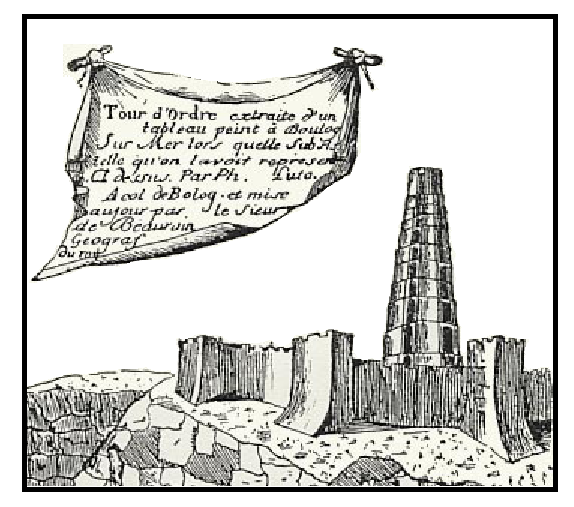 At last, as if resolved to wage war, he drew up his army on the shore of the ocean [the English Channel – Northern France], with his ballistas and other war machines. And while no one could imagine what he intended to do, he suddenly commanded them to gather up seashells, and fill their helmets and the folds of their tunics with them, calling them ” the spoils of the sea due to the Capitoline and the Palatine.”
At last, as if resolved to wage war, he drew up his army on the shore of the ocean [the English Channel – Northern France], with his ballistas and other war machines. And while no one could imagine what he intended to do, he suddenly commanded them to gather up seashells, and fill their helmets and the folds of their tunics with them, calling them ” the spoils of the sea due to the Capitoline and the Palatine.”
As a monument to his success, he erected a lighthouse, upon which, as at the Pharos of Alexandria, he ordered lights to be burned in the nighttime for the direction of ships at sea. Finally, promising the soldiers a reward of a hundred denarii each, as if he had surpassed the most eminent examples of generosity, he said “Go your ways and be merry; for now you are rich!”
(Suetonius, Life of Caligula, 46)
After Caligula returned to Rome, there was a lot of fighting in the Rhineland. The governor of Germania Inferior, Aulus Gabinius Secundus, overcame the Chauci and recovered one of the eagle standards that had remained in the hands of the enemies after the battle in the Teutoburg Forest. At the same time, Servius Sulpicius Galba (the future emperor) overcame the Chatti, who lived near Mainz. XXII Primigenia must have been involved in one of or even both campaigns, which are dated to the winter of 40/41.
Upon Caligula’s return to Rome, he degenerated even further. He began to view himself as a living God, something common in Asian culture but not in Rome. He built a temple for himself on the Palatine Hill and forced wealthy citizens to pay enormous sums to be his high priests. Suetonius tells us that Caligula began to change his attire, dressing one day as a man and the next as a woman. He would often appear with a golden beard, holding a thunderbolt, trident, or caduceus – various symbols of the gods. He even dressed at times as Venus and on other occasions in the garb of a victorious general, even when there were no victories.
Caligula took four wives, almost one after the other. He had first married Junia Claudia back in 33 AD, who soon died in childbirth. His second wife was Livia Orestilla who was engaged to Gaius Calpurnius Piso when Caligula took her in 37AD in the middle of the wedding celebrations. That affair lasted only two months before casting her aside. In 38 AD, his third wife was Lollia Paulina, who was also quickly divorced. His fourth and final wife was not so lucky. She was Milonia Caesonia and several years his senior. She was married to Caligula in the summer of 39 AD. Caesonia had lived with Caligula as his mistress, and a month after their marriage, a daughter named Julia Drusilla was born in memory of his beloved sister.
By the year 40 AD, the insanity, personal depravity, and oppression of the Senate had become too much. Another plot was discovered, resulting in the execution of several senators. But support for Caligula was vanishing everywhere. Finally, a wider plot developed with the principal players Cassius Chaerea and Cornelius Sabinus, Arrecinus Clemens, commander of the guard, the palace secretary Callistus, several senators, and additional members of the praetorian guard.
The assassination took place on January 24th, 41 AD. Chaerea slashed Caligula’s throat from behind, followed by Sabinus striking a blow into the chest, causing him to fall to the ground, where the others jumped in, delivering some thirty blows. The conspirators quickly moved to the palace, killing Caesaonia and her daughter Julia Drusilla in hopes of ending the monarchy. But the German imperial bodyguard was ready to plunge the city into a general massacre as they hunted down the assassins.
The Senate tried to muster support to retake power but failed to gain the support of the praetorian guard. As the story goes, upon the discovery of Caligula’s uncle Claudius hiding behind the curtains in the palace, he was hailed as emperor by the soldiers, thus ending the Senate’s move to restore the Republic. We can see that Claudius issued a gold aureus, picturing the Praetorian Guard camp, basically informing everyone he was made emperor by the Praetorians.
Mausoleum of Augustus
Caligula’s body was taken in secret by Herod Agrippa of Jewish history, and part of his body was cremated on Esquiline Hill. The remaining portions of his body were later cremated by his two surviving sisters, Agrippina, Jr, and Livilla, upon their return to Rome from exile. His ashes were eventually deposited in the Mausoleum of Augustus.
The hatred for Caligula ran deep. His name was erased from many public inscriptions, his statues pulled down and destroyed, and his coinage recalled and melted whenever possible.
Titles and Powers, 37-41 AD
Yr Tribunician Power Imperatorial Acclamation Consulship Other
37 TR.P. COS. AVGVSTVS. P.M.
38 TR.P. – TR.P.II. P.P.
39 TR.P.II. – III. COS.II.
40 TR.P.III. – IIII. COS.III.
41 TR.P.IIII. COS.IIII.
Note: Caligula’s tribunician power was renewed each year on March 18th.
Monetary System
Mints: -Rome, Lugdunum, Caesarea
Obverse Legends
- C CAESAR AVG
- C CAESAR AVG GERM
- C CAESAR AVG GERMANICVS
- C CAESAR AVG GERMANICVS PON M TR POT
- C CAESAR DIVI AVG PRON AVG
DENOMINATIONS
AU Aureus (7.63 grams)
AU Quinarius
AR Denarius (3.61 grams)
Æ Sestertius
Æ As
Æ Quadrans
(COUNTERSTAMPS)
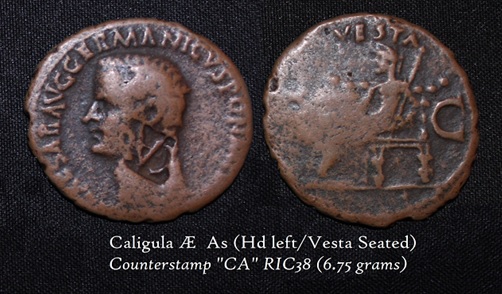
Æ As (Hd left/Vesta Seated) “CA” Counter stamp
Æ As ( (TIB) C(LA) (IMP) in a rectangular countermark Pangerl 51)
Æ As (UNPUBLISH Countermark “T” applied mid 1st century AD(?)
Æ23 As Countermark of Claudius “I•S” in rectangular stamp,
Colonial
BOSPORUS
AV Stater (KINGS of BOSPORUS. Mithradates III, with Caligula. AD 39/40-44/5.)
AV Stater (KINGS of BOSPORUS. Mithradates III, with Claudius. AD 39/40-44/5.)
AR Drachm CAESAREA (/Simpulum)
AR Drachm CAESAREA (/Simpulum) 92%
AR Drachm CAESAREA (w/Augustus)
CAESARAUGUSTA
Æ31 Caesaraugusta (Laur hd left/Plowing field CCA)
Æ31 Caesaraugusta (Laur hd left/Plowing field CCA)
CRETE
Æ31 Caesaraugusta (Laur hd left/Plowing field CCA)
JUDAEA
Æ23 JUDAEA (Agrippa I Yr 5 Caligula lf/Germanicus quad rt)
Æ23 JUDAEA (Agrippa I Yr 5 Caligula lf/Germanicus quad rt)
AE21 SMYMA (Laur hd rt/Drusilla seated left)
AE16 SMYMA (Laur hd rt/Nike Adv rt)
LYCIA
Æ20 LYCIA, Balbura (hd rt/ Hercules stndg)
Æ17LYCIA, Balbura (hd rt/ Hercules stndg)
LYDIA
Æ17 LYDIA. Philadelphia. Caligula right/ Laur jugate, of the Dioscuri to right
AE20 LYDIA Magnesia ad Sipylum (Radiate hd r/Germanicus & Agrippina)
AE20 LYDIA Magnesia ad Sipylum (Radiate hd r/Germanicus & Agrippina)
AE17 LYDIA. Philadelphia (Laur hd r/Jugate Busts with Dioscuri)
AE17 LYDIA. Philadelphia (Laur hd r/Jugate Busts with Dioscuri)
AE17 LYDIA. Philadelphia (Laur hd r/Panther walking r)
AE18 LYDIA. Philadelphia (Hemiassarion) (Laur hr rt/ Agrippina I seated r)
AE20 LYDIA Tripolis (Diassarion) (bare hd rt/Horseman r axe on shoulder)
Æ22 MACEDON, Thessalonica (Laur hd left / ΘΕΣΣΑΛο/•/NIKEΩΝ in three lines within wreath.
PHRYGIA
Æ20 PHRYGIA, Aezanis. (laur hd rt / Artemis bust rt)
Æ18mm (Laur hd right / Zeus standing left)
Æ20 PHRYGIA, Aezanis. (Radiate hd rt / Zeus standing left)
Æ20 PHRYGIA. Amorium. (bare hd rt/Eagle)
SPAIN
AE28 SPAIN, SEGOBRIGA (Laur hd rt/Sego in wreath)
AE22 SPAIN, SEGOBRIGA (Laur hd rt/Sego in wreath)
AE As SPAIN Caesaraugusta
THRACE
Æ30 THRACE (Caligula hd left/Claigula presenting diadem to Rhoemetalkes III)
Æ26 THRACE (Caligula, with Rhoemetalkes III)
AE22 Thrace Rhoemetalkes III, circa AD 38-46. (Caligula left/Nike stndg r)
TROAS
AE23 TROAS. Ilium. (Caligula facing Divus Augustus/Roma facing Roman Senate; between Athena)
AR Contemporary Denarius Fourrée (Hd rt Caligula/Hd rt Caligula) Struck probably after 40AD
Modern Reproductions
Ӕ Sestertius 3 sisters (edge marked MB (= Münzkabinett Berlin)
Ӕ Sestertius(Pietas seated left/Caligula sacrificing)
Ӕ Sestertius(Laur hd left/Addressing Ttroops)


